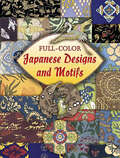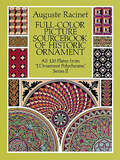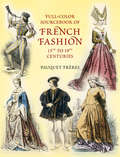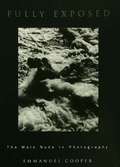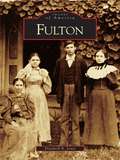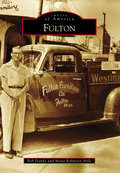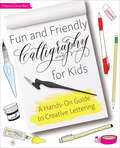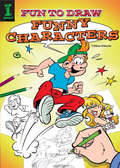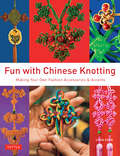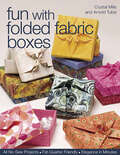- Table View
- List View
Full of Heart: My Story of Survival, Strength, and Spirit
by J. R. Martinez Alexandra Rockey FlemingAn inspirational journey from tragedy to triumph In 2003, nineteen-year-old Private J. R. Martinez was on a routine patrol when the Humvee he was driving hit an antitank mine in Iraq, resulting in severe injuries and burns on his face and more than one-third of his body. Out of that tragedy came an improbable journey of inspiration, motivation, and dreams come true. In Full of Heart, Martinez shares his story in intimate detail, from his upbringing in the American South and his time in the Army to his recovery and the indomitable spirit that has made him an inspiration to countless fans. J. R. Martinez always had a strong spirit. Raised in Bossier City, Louisiana, and then Hope, Arkansas, by a single mother from El Salvador, he was well known at school for his good looks and his smart mouth. At seventeen, showing an early determination and drive that would become one of his trademark qualities, J. R. convinced his mom to move to Dalton, Georgia, where he believed he would have a better chance of being recruited to play college football. His positive attitude earned him a spot on a competitive high school football squad, but when his college dreams collapsed, he turned to the U. S. Army. A few months later, he found himself serving in Iraq. When J. R. 's humvee hit a mine and exploded--just one month into his deployment--he was immediately evacuated to a San Antonio medical center, where he spent the next thirty-four months in grueling recovery. Seeing his disfigured face for the first time after the accident threw him into a crushing period of confusion and anger. His spirits were low, until he was asked to speak to another young burn victim. J. R. realized how valuable and gratifying it was to share his experiences with other patients and listen to theirs. He'd found a calling. His fellow soldiers, along with the local and then national media, soon latched onto J. R. 's spirit and strength. His resilience, optimism, and charm were also noted by Hollywood and scored him roles on All My Children and Dancing with the Stars, where he was the season thirteen champion. Today, J. R. tours the country sharing his story and his lessons for overcoming challenges and embracing hope, lessons that abound in this book. Full of Heart is an unforgettable story of a man who never gave up on his dreams. After being injured in Iraq, J. R. Martinez became a motivational speaker, actor, and winner of season thirteen of Dancing with the Stars. Martinez lives in Los Angeles
Full-Color Japanese Designs and Motifs (Dover Pictorial Archive)
by DoverThis rich array of exquisite designs includes all the most popular Japanese motifs. Ferocious dragons with scaly skins, cranes with wide-spread wings, as well as tigers, phoenixes, and peacocks abound; so do lush peonies and many other flowers, plants, and animal designs. Geometric, abstract, and allover patterns are also included. More than 130 dazzling, royalty-free images -- reproduced from rare nineteenth-century portfolios -- are ideal for direct use in art and craft projects. They'll also serve as a wondereful source of inspiration for any design work calling for authentic Japanese flavor.
Full-Color Picture Sourcebook of Historic Ornament: All 120 Plates from "L'Ornement Polychrome," Series II (Dover Fine Art, History of Art)
by Auguste RacinetClassic sourcebook of spectacular royalty-free design collages, featuring over 1,500 decorative elements and motifs from major cultures in history through the 19th century, from Asia and Africa to Europe and the Americas. Adapted from jewelry, illuminated manuscripts, weapons, tiles, carved wood panels, ceilings, inlay, hardware, ceramics and more.
Full-Color Sourcebook of French Fashion: 15th to 19th Centuries
by Pauquet FrèresThese superb color plates by Hippolyte Pauquet and his brother Polydore, reproduced directly from a rare and valuable nineteenth-century publication, magnificently depict 500 years of French fashion.Starting with the flamboyant headgear and voluminous robes of fifteenth-century royalty, the artfully rendered illustrations progress chronologically to the high-waisted Empire styles of the Napoleonic era. Members of the nobility and upper classes are well represented here. Portraits of lavishly garbed court ladies and gentlemen -- many in fur-trimmed robes -- appear next to dapper pages and handsome knights. Bourgeois fashions (including lace-trimmed garments for both sexes) are presented as well, along with the more modest attire of chambermaids, milkmaids, and shepherdesses. Images of such historic figures as King Henri VI, Madame de Pompadour, Madame du Barry, and Marie Antoinette complete a splendid collection.A valuable reference for costume designers and fashion historians, this beautifully reproduced volume will also serve as a grand treat for fashion enthusiasts.
Full-Figure Fashion: 24 Plus-Size Patterns for Every Day (BurdaStyle Modern Sewing)
by Burdastyle MagazineSew stylish, flattering garments with Burda patterns! BurdaStyle is a legendary brand that focuses on the fashionable, high-style, "in" sewing marketplace. Sewists know the BurdaStyle name and its reputation for high-quality sewing patterns. BurdaStyle Modern Sewing: Full-Figure Fashion includes 25+ of the best plus-size projects from the archives of BurdaStyle magazine. All of the must-have basics of a woman's wardrobe are covered in this collection--jackets, pants, blouses, skirts, and dresses. The designs include versatile separates as well as combinations that further expand the possibilities for the modern woman's wardrobe. In addition to the 25+ Burda patterns, there are several variations. The projects are easy to intermediate and sizes range from 14 to 24. Although this book is not meant to be a primer on sewing, it includes a Burda 101 section that covers everything the reader needs to know to follow the sewing patterns, including frequently used techniques, and a pattern insert with full-size pattern pieces.
Fullspace-Projektion
by Gordian Overschmidt Ute SchröderDas Fachbuch liefert erstmals einen umfassenden Überblick über Konzeption, Produktion und Anwendung von 360°-Welten und erkundet damit die Potenziale eines neuen Marktes. Experten vermitteln den aktuellen Stand zu Themen wie den neurobiologischen Grundlagen, Story-Telling, Drehbuch, Visual Effects oder Projektionstechnologie. Darüber hinaus diskutieren sie Marketing- und Vertriebsfragen und geben einen Ausblick auf den Einsatz von Fullspace-Projektionen in Bildung, Entertainment und Medizin. Mit Projektskizzen als Beispiele für Praxisanwendungen.
Fully Exposed: The Male Nude in Photography
by Emmanuel CooperFully Exposed is a pioneering cultural history of the photography of the male nude which sets the photographer and the model within our cultural and historical perceptions and prejudices. This second edition extends the book's coverage so that the story from the beginnings of the medium to the present day is complete.Fully Exposed is lavishly illustrated with over two hundred and fifty photographs,many of them new to this edition. Different chapters discuss how the male nude has been used by artists, the way it has been treated in the popular press,in relation to British colonialism and scientific ideology. It also discusses `private pictures' taken at home or acquired as erotic material by the private collector. A final chapter brings the book up-to-date and discusses the male nude in the nineties.The combination of art criticism and photographic essay make this an unusual and important book both for academics and the general reader.
Fulton
by Elizabeth R. JonesLocated in the southwestern part of the state, Fulton, Kentucky was first known as Pontotoc by the native Chickasaw Indians. The town was founded in 1828, along with its sister city, South Fulton, Tennessee, when Benjamin Franklin Carr purchased 160 acres from the Commonwealth of Kentucky. The town was labeled the "end of the line" by the federal government due to its pivotal position at the termination point of the Paducah-Memphis rail-all mail sent to the region was addressed as such. Images of America: Fulton follows the agricultural and industrial development of the region, and provides local folklore as well.
Fulton (Images of America)
by Bob Franks Mona Robinson MillsFulton is one of the oldest cities in northern Mississippi. Established on May 11, 1837, by an act of the Mississippi legislature, the city is the northernmost town on the Tombigbee River, located less than 10 miles south of that river’s headwaters. Fulton was settled by hardy pioneers seeking new opportunities in the newly available lands of Mississippi’s Chickasaw Cession. From its first days, Fulton was the center of commercial activity in Itawamba County, as well as the home to county government. During the Civil War and Reconstruction, the town declined, until a period of new growth and activity took place during the early 20th century. At that time, the timber industry became a lucrative venture, and the Mississippian Railway was established, connecting Fulton to the Frisco Railroad in Amory, 20 miles to the south. Fulton is now home to Itawamba Community College and is adjacent to the Tennessee-Tombigbee Waterway, one of the largest inland waterways in the nation.
Fun & Easy Origami
by Tuttle PublishingMake colorful and fun paper craft projects with this easy origami ebook.Fun & Easy Origami is perfect for people of any age including the beginner paper folder or for those more advanced looking to expand their repertoire. This delightful paper craft ebook makes origami simple and includes a variety of animals and toys; from a flying fish, dragon puppet and birthday card to a dollhouse bed, coin trick and jump-up insect. Use it to craft eye-catching origami for your friends, to beautify your home-or as a wonderful gift for origami lovers.All of the folds are simple enough to be origami-for-kids projects and are a great way to learn origami. The origami ebook contains: 2 full-colored, 32-page booklets Clear step-by-step instructions Easy-to-follow diagrams 20 simple origami projectsFun & Easy Origami provides you this stunning collection of origami projects that will have you creating origami masterpieces in no time!Origami projects include: Wind Toy Treasure Box Dragon Puppet Coin Trick UFO And many more...
Fun & Easy Paper Airplanes
by Andrew DewarFun & Easy Paper Airplanes contains detailed instructions for 16 original paper airplanes that will make you an experienced folder in no time. 84 easy-to-remove perforated pages,which include folding lines right in the designs, will have you creating origami planes that really fly in a matter of minutes!The instructions, by international paper airplane expert Andrew Dewar, contain many handy practical tips that will help you not only fl y your planes, but fl y them farther and faster than you ever thought possible. Fun & Easy Paper airplanes also includes a full-color photo of each finished project and interesting facts about each plane, as well as tips on how to create your own original airplane designs.
Fun & Funky Cross Stitch: 160+ Designs, 5 Alphabets, 30 Bonus Gift Ideas
by Immediate MediaCraft a collection of eclectic designs from top cross-stitch artists around the world—including wildlife, space elements, retro-themed motifs, and more!You’ve always wanted to hand stitch wild and wacky designs. Now you can with this fabulous collection of cutting-edge cross-stitch designs. Cross-stitch animals, nature, and so much more with helpful guides to each project. Designs range from beginner-friendly to more advanced, and with 160+ designs there are plenty to keep you reaching for this book again and again. Customize your colors or match the ones given; each project includes color numbers from DMC, Anchor, and Madeira. Sit back and enjoy the process of hand stitching bold and bright designs from some of the most popular cross-stitch designers! Fun & Funky Cross Stitch includes a beginners guide to the basic stitches, the stitch chart, and supplies lists. Each design has a skill level suggestion and an estimated time of completion.
Fun Face Painting Ideas for Kids: 40 Step-by-Step Demos
by Nick Wolfe Brian WolfeDesign a silly face...or a scary one, or a fairy one, or anything else you can dream up! The world-renowned authors of Extreme Face Painting are taking it back to the basics, with some innovative twists. All ages and all skill levels will learn the secrets to creating awesome face art with easy-to-find materials, friendly instruction for beginners, and fresh inspiration for more seasoned face painters. 40 all-new, step-by-step projects. Award-winning expert techniques for creating believable face paint designs. Beginners will learn to paint everything from simple flowers to a full Frankenstein face. Intermediate artists will learn techniques for creating the look of fur, the illusion of depth, and more intricate designs like and owl mask or a spitting cobra. So grab some supplies and get ready to put a new face on fun!
Fun With Washi!
by Angie Cao Jessica OkuiWashi tape has become the obsession of crafters, scrapbookers, and package fanatics, and now they'll know just how many ways to use it! This inspiring craft book presents 35 delightfully unique and sophisticated projects for decorating the home, accessories, and stationery with washi tape. Using simple techniques and basic materials, crafters can create a pixel heart to adorn their walls, accessorize their favorite shirt with a bow brooch, or create custom goodie bags for gifting treats. With helpful how-to illustrations, easy-to follow techniques for working with washi, and gorgeous photos of the finished projects, Fun with Washi makes it easy to add colorful accents everywhere.
Fun and Easy Paper Airplanes
by Andrew DewarMake exciting and simple paper airplanes with this origami book and folding papers. Fun & Easy Paper Airplanes presents a collection of realistic origami paper airplanes from well-known author and paper aviation expert Andrew Dewar. The simple but interesting designs will have you or your children folding like a pro in minutes. All the origami projects are designed to be simple enough to be considered "origami-for-kids" projects, and can be assembled by beginning origami folders. Paper airplanes are a great way for children to learn origami and gain an interest and appreciation for this fascinating art form. The finished origami planes look as awesome as they fly! This origami book contains: Full-colored origami assembly book Step-by-step instructions and diagrams 16 original design projects for planes Fun and accessible for both the paper crafts novice and the more season paper folder, this wonderfully giftable origami book gets you started right away and is a great value. Origami airplane projects include: Diamond Dart Star Clipper Wave Rider Jumping Jack Stingray And many more...
Fun and Fantastical Slippers to Knit: Flora, Fauna, and Iconic Styles for Kids and Grownups
by Mary Scott HuffGive the gift of spectacular slippers with these clever and creative patterns—from adorable bunnies to peas and carrots and Dorothy's ruby slippers!Do you know someone who could use a pair of beyond-cute slippers that resemble owls or goldfish? Is there someone in your life who might enjoy relaxing indoors in court jester booties? Fun and Fantastical Slippers to Knit shares funny and unique slipper patterns, plus practical instructions for a variety of techniques. The twenty knit slippers in this book are designed to fit kids or adults and are coveted by guys and gals alike. They represent a number of knitting styles, with some knitted and felted for extra warmth. Designed by author Mary Scott Huff, these slippers are every bit as adorable, and quirky as her fantastical hats!
Fun and Friendly Calligraphy for Kids: A Hands-On Guide to Creative Lettering
by Virginia Lucas HartEVERYTHING A BEGINNER CALLIGRAPHER NEEDS TO KNOW TO GET STARTED WITH BEAUTIFUL HANDWRITING.The art of calligraphy doesn&’t teach you how to write words, but instead, how to draw them. With this book&’s fun and playful approach, you will not only improve your handwriting skills, you&’ll have an absolute blast while doing so! You&’ll learn everything from A to Z, including how to make letterforms, mix inks and develop a unique lettering style.Follow the clear and easy instructions with countless helpful tips. Before you know it, you&’ll be creating beautiful projects, such as:• Wonderful thank-you notes & properly addressed envelopes• Flourished tags & cards for special occasions• Unique signatures & autographs• Personalized gifts & keepsakes• Fun logos & monograms
Fun of the Fair: Stuffed Animal Patterns for Sewn Toys (Melly & Me: Fun Fabulous Design)
by Melanie McNeiceThe designer behind Melly & Me shares five delightful animal toys even beginners can sew themselves with this step-by-step guide.Sewers of all abilities will love this fabulous new collection of toy patterns from Melly McNeice of Melly & Me! This bright and colorful collection features sewing patterns for five super cute fairground animals—choose from a pretty pony, ric rac the lion, a performing seal, some cheeky monkeys, and a family of elephants!All the patterns are suitable for beginner sewers and include easy to follow, detailed instructions and diagrams. Melly McNeice is the designer behind Melly & Me and is known for her fun sewn toy patterns, her previous books include Sewn Toy Tales and Snug as a Bug!
Fun to Draw Funny Characters
by T. BeaudenonCreate Funny Art With No Reading! With just a few simple steps, you can draw just about any kind of funny character! Inside you'll find 16 characters, twenty faces and endless comical situations that are fun and easy no matter what your skill level.
Fun to Draw Mangamon
by T. BeaudenonCreate Mangamon With No Reading! Everybody needs mangamon (mini manga monsters)! These mangamon are easy to draw with just a few simple steps. Inside you'll learn to draw 21 cute and ferocious characters for all your stories!
Fun to Draw Mini Mangas
by T. BeaudenonCreative Mini Mangas Big eyes, oversized heads and mischievous minds make mini manga characters (also called chibis) extra fun to create. You can draw them in a snap in just a few simple steps! Follow along with the step-by-step demonstrations inside to make 21 different chibis in no time at all.
Fun with Chinese Knotting
by Lydia ChenDetailed instructions, clear diagrams and lovely color photographs combine to make craft bookFun with Chinese Knotting both attractive and useful—displaying the many creative uses these decorative knots can have, and the great variety of materials used to make them. This delightful book is sure to be a rich source of inspiration for craftspeople everywhere. The art of Chinese knotting or macrame, has a surprisingly contemporary appeal, author artist Chen focuses on the decorative uses of Chinese knots to create your own personal fashion accessories which include: Hair ornaments Earrings Necklaces Pendants Brooches Belts Bracelets and anklets Accents that may be added to items of clothing Chinese knots are attractive and alluring along with being an Asian craft that is relatively easy to learn. Used for a variety of practical and decorative purposes—to record events, to fish and hunt, to wrap and tie items, as ornamental works of art, and even to communicate,Fun with Chinese Knotting will allow readers to create something for anyone.
Fun with Cork: 35 Do-It-Yourself Projects for Cork Accessories, Gifts, Decorations, and Much More!
by Jutta Handrup Maike HedderLet yourself be fascinated by cork!Cork is so much more than just pin boards and trivet. Today, there are an incredible number of cork materials: fabrics, paper, construction paper and adhesive foils made from an absolutely sustainable natural product. Cult bloggers and trendsetters Jutta and Maike von Kreativfieber show in this book what you can do with these wonderful materials. All projects are easy to imitate and bring through their stylish design and the unique feel of the cork a very special flair in the apartment and wardrobe. Included here are instructions for decorating, upcycling, and accessories using cork paper, adhesive film, and arches.
Fun with Folded Fabric Boxes: All No-Sew Projects, Fat-Quarter Friendly, Elegance in Minutes
by Crystal Mills Arnold TubisA Bounty of Boxes to Fashion From Fabric & Paper. Quick and easy no-sew techniques for making beautiful origami boxes with our easy-to-follow how-to illustrations and photos. Make in a variety of sizes-and have fun embellishing them! There is no limit to the ways you can use these impressive boxes: pretty storage, home decor accents, gift boxes, party favors...Inspired by a traditional folded Japanese box (masu), the boxes can be funky, lavish, or elegant depending on the materials you choose. Perfect for fat quarters or those special papers you've been saving. Includes lots of embellishment ideas.
Fun with Mirrors
by Liz HuyckMaking the perfect mirror surface of Chicago's Cloud Gate sculpture took a lot of work.

